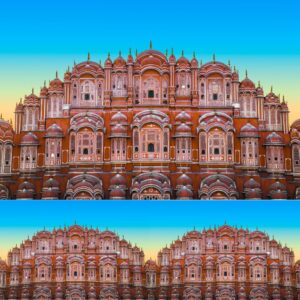Jaipur Tour: The Royal Journey Through the Pink City

𝗝𝗮𝗶𝗽𝘂𝗿 𝗧𝗼𝘂𝗿: 𝗧𝗵𝗲 𝗥𝗼𝘆𝗮𝗹 𝗝𝗼𝘂𝗿𝗻𝗲𝘆 𝗧𝗵𝗿𝗼𝘂𝗴𝗵 𝘁𝗵𝗲 𝗣𝗶𝗻𝗸 𝗖𝗶𝘁𝘆
The capital city of Rajasthan, Jaipur, is a vibrant blend of history, culture, and architectural splendor. Known as the Pink City, Jaipur boasts a rich heritage with its majestic forts, royal palaces, and colorful bazaars. It forms a part of India’s famous Golden Triangle tourist circuit, alongside Delhi and Agra, making it a must-visit destination for travelers seeking to explore India’s regal past.
Jaipur was founded in 1727 by Maharaja Sawai Jai Singh II, who built it as India’s first planned city, with broad avenues and well-designed buildings. Today, it stands as a testament to the grandeur and opulence of the Rajput era, offering an immersive experience into Rajasthan’s royal history.
Let’s embark on a virtual tour of Jaipur, exploring its most iconic attractions, cultural highlights, and travel tips for a memorable visit.
1. Amber Fort: A Majestic Marvel
Perched atop the Aravalli Hills, Amber Fort (also known as Amer Fort) is one of the most iconic landmarks of Jaipur. This massive fort, built from red sandstone and marble, offers a spectacular view of Maota Lake and the surrounding landscape. The fort is a blend of Rajput and Mughal architecture, featuring intricate carvings, sprawling courtyards, and grand palaces.
Top Highlights of Amber Fort:
Sheesh Mahal (Mirror Palace): One of the most stunning sections of the fort, the Sheesh Mahal is adorned with thousands of tiny mirrors, which reflect light and create a dazzling effect.
Elephant Ride: Visitors can take an elephant ride up to the fort’s entrance, adding a regal touch to their experience.
Light and Sound Show: In the evenings, a light and sound show narrates the history of Amber Fort, giving visitors a deeper understanding of its significance.
2. City Palace: A Royal Residence
Located in the heart of Jaipur, the City Palace is a magnificent palace complex that served as the seat of the Maharaja of Jaipur. Built in the 18th century, the palace is a fine example of the fusion between Rajput and Mughal architecture. It continues to be the residence of the Jaipur royal family and also houses a museum that showcases royal artifacts, costumes, and weapons.
Must-See Sections of City Palace:
Chandra Mahal: This seven-story palace is still the residence of the royal family, though the ground floor is open to the public.
Mubarak Mahal: This section houses the Maharaja Sawai Man Singh II Museum, which features royal costumes, shawls, and finely woven textiles.
Pitam Niwas Chowk: The four intricately designed gates, representing the four seasons, are a visual treat and one of the most photographed spots in Jaipur.
3. Hawa Mahal: The Palace of Winds
The iconic Hawa Mahal, with its unique five-story façade, is perhaps the most recognizable symbol of Jaipur. Built in 1799 by Maharaja Sawai Pratap Singh, the Palace of Winds has 953 small windows, or jharokhas, designed to allow royal women to observe street festivals and daily life without being seen.
Things to Know About Hawa Mahal:
The building’s design resembles the crown of Lord Krishna.
The latticework allows cool air to pass through, making the palace a perfect retreat during hot summers.
Climb to the top for panoramic views of the Jantar Mantar and City Palace.
4. Jantar Mantar: The Astronomical Observatory
A UNESCO World Heritage Site, Jantar Mantar is an astronomical observatory built by Maharaja Sawai Jai Singh II in 1734. It is the largest and best-preserved observatory of the five built by the king across India. The site consists of 19 massive instruments used to measure time, predict eclipses, and track celestial bodies.
Top Instruments to See at Jantar Mantar:
Samrat Yantra: The largest sundial in the world, this instrument measures time with incredible precision.
Rama Yantra: Used to measure the altitude of stars.
Jai Prakash Yantra: Helps observers locate the position of celestial objects.
5. Jal Mahal: The Water Palace
Located in the middle of Man Sagar Lake, Jal Mahal is a beautiful palace that appears to float on the lake’s waters. While entry into the palace is restricted, the view from the shore is breathtaking, especially during sunrise or sunset. The palace is a fusion of Rajput and Mughal architecture, and its unique setting makes it a perfect spot for photography
